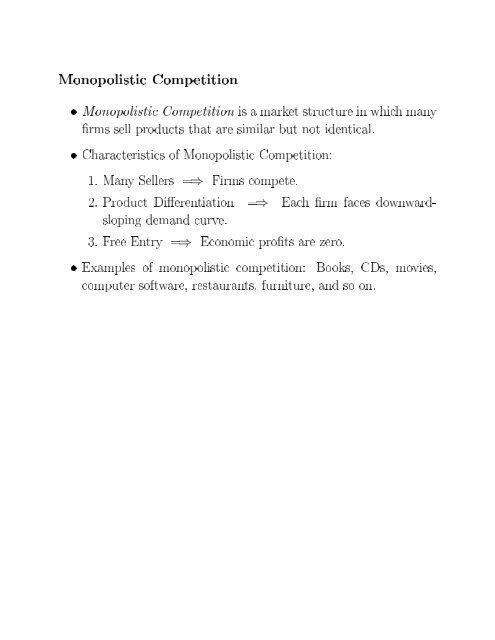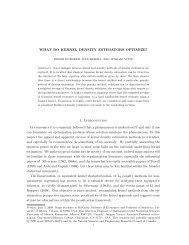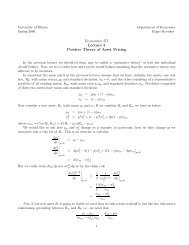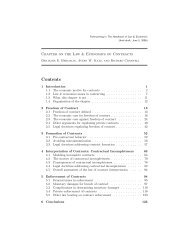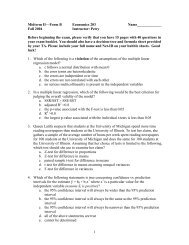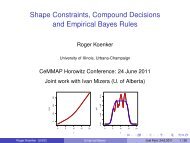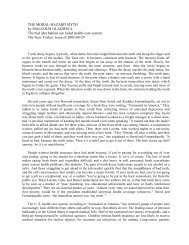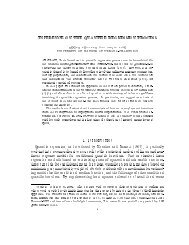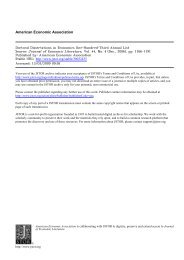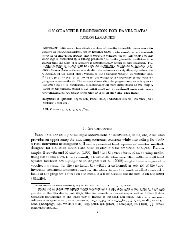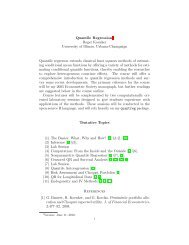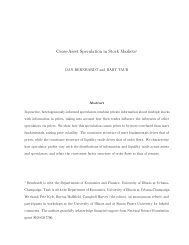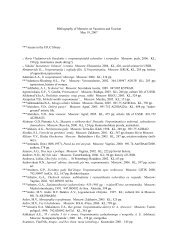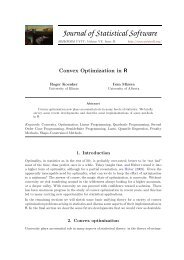Monopolistic Competition
Monopolistic Competition
Monopolistic Competition
Create successful ePaper yourself
Turn your PDF publications into a flip-book with our unique Google optimized e-Paper software.
<strong>Monopolistic</strong> <strong>Competition</strong><br />
<strong>Monopolistic</strong> <strong>Competition</strong> is a market structure in which many<br />
rms sell products that are similar but not identical.<br />
Characteristics of <strong>Monopolistic</strong> <strong>Competition</strong>:<br />
1. Many Sellers =) Firms compete.<br />
2. Product Dierentiation =) Each rm faces downwardsloping<br />
demand curve.<br />
3. Free Entry =) Economic prots are zero.<br />
Examples of monopolistic competition: Books, CDs, movies,<br />
computer software, restaurants, furniture, and so on.
<strong>Competition</strong> with Dierentiated Products<br />
The <strong>Monopolistic</strong>ally Competitive Firm in the Short Run<br />
Each rm in monopolistic competition faces a downward-sloping<br />
demand curve.<br />
The monopolistically competitive rm follows the monopolist's<br />
rule for maximizing prot.<br />
1. It chooses the output level where marginal revenue is equal<br />
to marginal cost.<br />
2. It sets the price using the demand curve to ensure that consumers<br />
will buy the amount produced.<br />
We can determine whether or not the monopolistically competitive<br />
rm is earning a prot or loss by comparing price and average<br />
total cost.<br />
1. If P > ATC , the rm is earning a prot.<br />
2. If P < ATC , the rm is earning a loss.<br />
3. If P = ATC , the rm is earning zero economic prot.
The Long-Run Equilibrium<br />
When rms in monopolistic competition are making prot, new<br />
rms have an incentive to enter the market.<br />
1. This increases the number of products from which consumers<br />
can choose.<br />
2. Thus, the demand curve faced by each rm shifts to the left.<br />
When rms in monopolistic competition are incurring losses,<br />
rms in the market will have an incentive to exit.<br />
1. Consumers will have fewer products from which to choose.<br />
2. Thus, the demand curve for each rm shifts to the right.<br />
The process of exit and entry continues until rms are earning<br />
zero prot.<br />
1. This means that the demand curve and the average total cost<br />
curve are tangent to each other.<br />
{ Question: Why can't the demand curve cross the ATC<br />
curve?<br />
{ Answer: This would mean that P > ATC at some output<br />
level.<br />
2. At this point, price is equal to average total cost and the rm<br />
is earning zero economic prot.
<strong>Monopolistic</strong> Versus Perfect <strong>Competition</strong><br />
Excess Capacity<br />
1. The quantity of output produced by a monopolistically competitive<br />
rm is smaller than the quantity that minimizes average<br />
total cost (the ecient scale).<br />
2. This implies that rms in monopolistic competition have excess<br />
capacity, because the rm could increase its output and<br />
lower its average total cost of production.<br />
3. Because rms in perfect competition produce where price is<br />
equal to the minimum average total cost, rms in perfect<br />
competition produce at their ecient scale.<br />
Markup over Marginal Cost<br />
1. In monopolistic competition, price is greater than marginal<br />
cost because the rm has some market power.<br />
2. In perfect competition, price is equal to marginal cost.
<strong>Monopolistic</strong> <strong>Competition</strong> and the Welfare of Society<br />
One source of ineciency is the markup over marginal cost. This<br />
implies a deadweight loss (similar to that caused by monopolies).<br />
Because there are so many rms in this type of market structure,<br />
regulating these rms would be dicult.<br />
Also, forcing these rms to set price equal to marginal cost would<br />
force them out of business (since they are already earning zero<br />
economic prot).<br />
There are also externalities associated with entry.<br />
1. The product-variety externality occurs because as new rms<br />
enter, consumers get some consumer surplus from the introduction<br />
of a new product. (Positive externality.)<br />
2. The business-stealing externality occurs because as new<br />
rms enter, other rms lose customers and prot. (Negative<br />
externality.)<br />
3. Depending on which externality is larger, a monopolistically<br />
competitive market could have too few or too many rms.
Question: Is the excess capacity a problem?<br />
Answer: It is not clear that rms should always produce at the<br />
level which minimizes average total cost. For example, if the<br />
xed cost of writing a book is $500,000 and each book costs $5<br />
to reproduce,<br />
ATC =<br />
ATC is minimized when N = 1.<br />
$500 000 + N $5<br />
N<br />
:
Advertising<br />
The Debate over Advertising<br />
The Critique of Advertising:<br />
1. Firms advertise to manipulate people's tastes.<br />
2. Advertising reduces competition because it increases the perception<br />
of product dierentiation.<br />
The Defense of Advertising:<br />
1. Firms use advertising to provide information to consumers.<br />
2. Advertising increases competition because it allows consumers<br />
to be better informed about all of the rms in the market.<br />
3. Advertising is a complementary good. Advertising increases<br />
the pleasure one gets from purchasing a good.
Advertising as a Signal of Quality<br />
The willingness of a rm to spend a large amount of money on<br />
advertising may be a signal to consumers about the quality of<br />
the product being oered.<br />
Example: Kellogg and Post have each developed a new cereal<br />
that it would sell for $3 per box. (Assume that the marginal<br />
cost of producing the cereal is zero.) Each company knows that<br />
if it spends $10 million on advertising, it will get 1 million new<br />
consumers to try the product. If consumers like the product,<br />
they will buy it again.<br />
1. Post has discovered through market research that its new<br />
cereal is not very good. After buying it once consumers<br />
would not be likely to buy it again. Thus, it will only earn<br />
$3 million in revenue, which would not be enough to pay for<br />
the advertising. Therefore, it does not advertise.<br />
2. Kellogg knows that its cereal is great. Each person that<br />
buys it will likely buy one box per month for the next year.<br />
Therefore, its sales would be $36 million, which is more than<br />
enough to justify the advertisement.<br />
3. By its willingness to spend money on advertising, Kellogg<br />
signals to consumers the quality of its cereal.
Note that the content of the advertisement is unimportant what<br />
is important is that consumers know that the advertisements are<br />
expensive.<br />
This is also the reason why banks (at least used to) have very<br />
fancy oces and men buy expensive (but completely useless)<br />
pieces of rock to their women.
Brand Names<br />
In many markets there are two types of rms some rms sell<br />
products with widely recognized brand names while others sell<br />
generic substitutes.<br />
Critics of brand names argue that they cause consumers to perceive<br />
dierences that do not really exist.<br />
Economists have defended brand names as a useful waytoensure<br />
that goods are of high quality.<br />
1. Brand names provide consumers with information about quality<br />
when quality cannot be easily judged in advance of purchase.<br />
2. Brand names give rms an incentive to maintain high quality,<br />
since rms have a nancial stake in maintaining the reputation<br />
of their brand names.<br />
This is one reason why Hollywood pays obscene amounts of<br />
money for its action stars.


